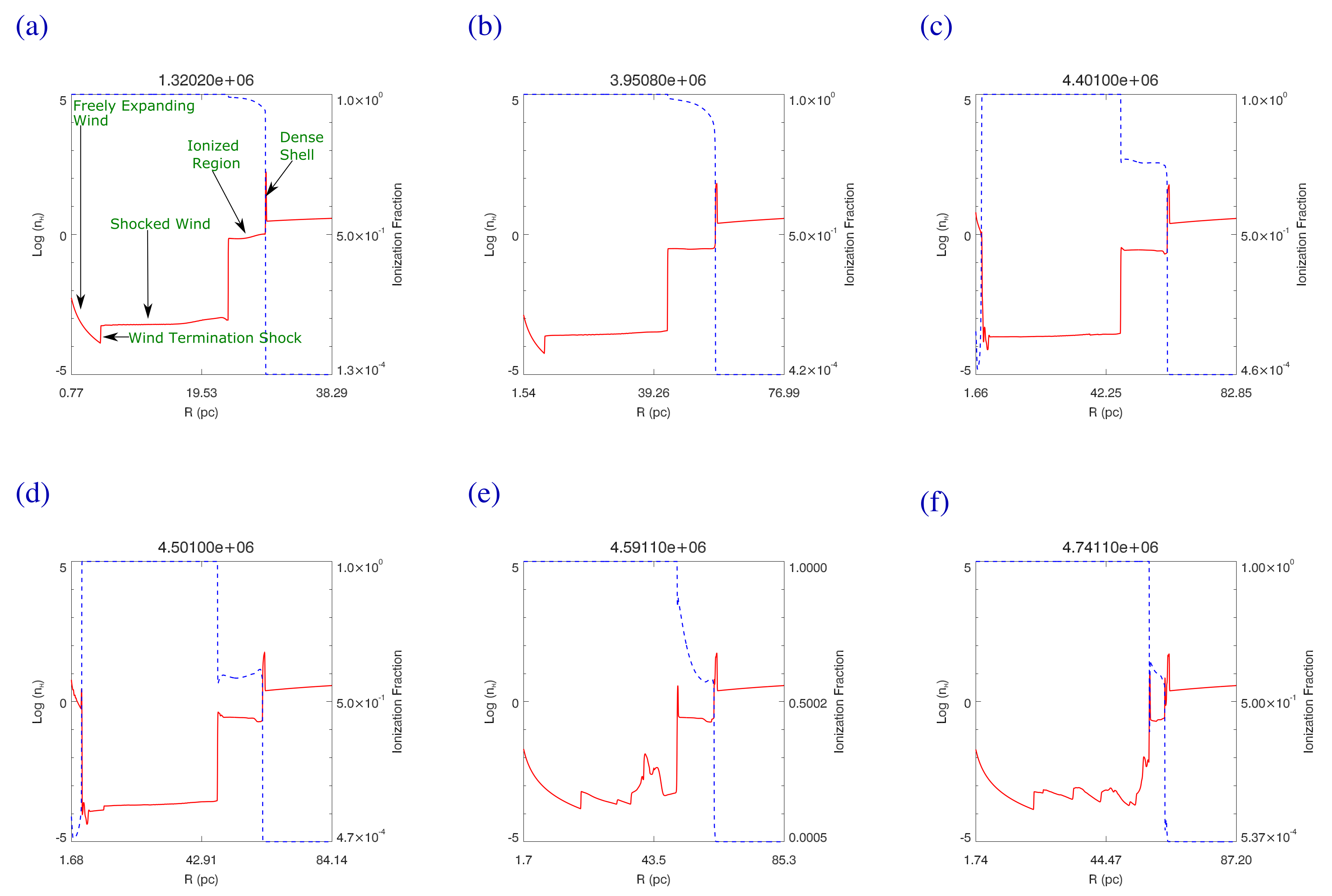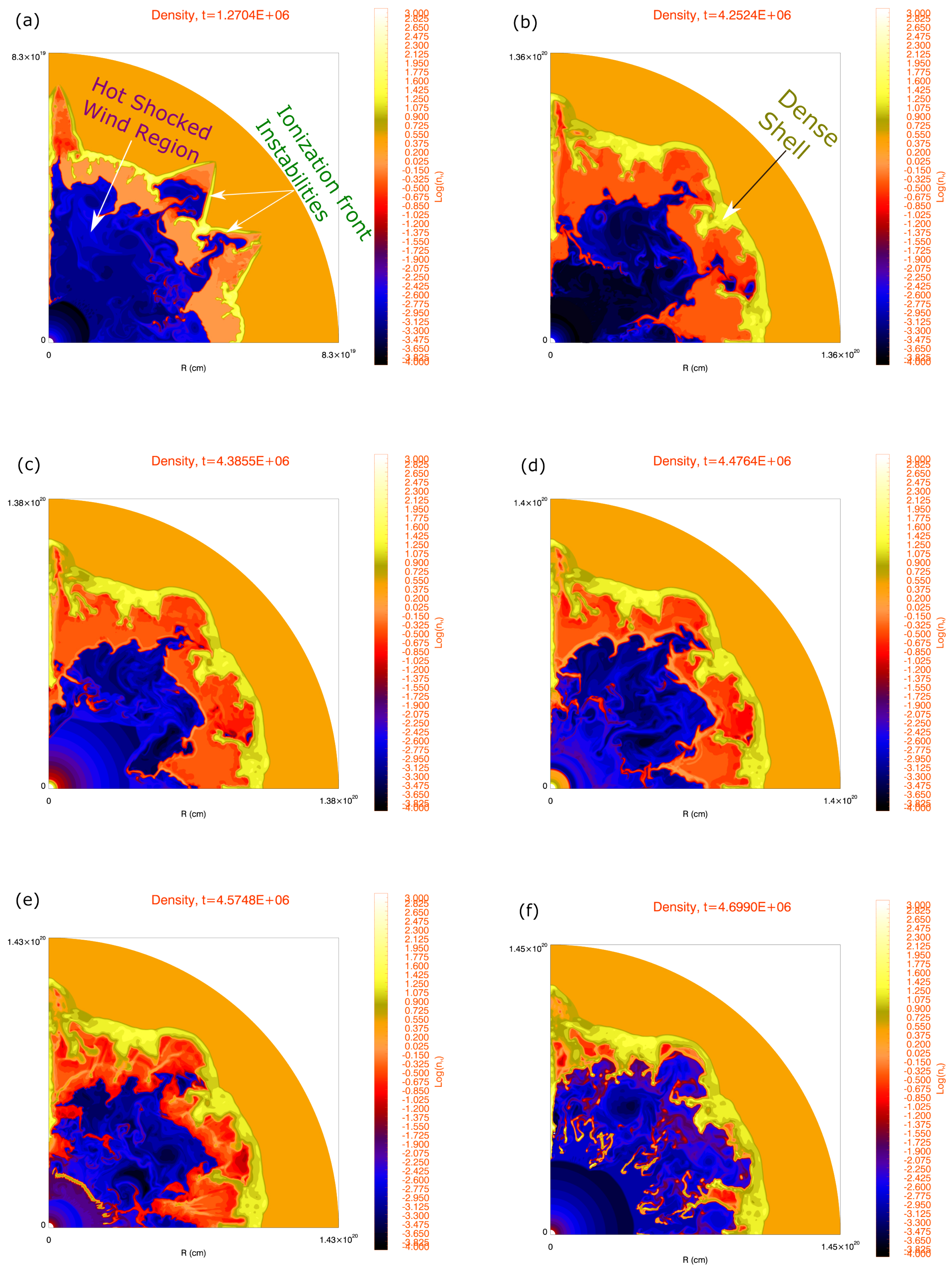Ionization-Gasdynamic Simulations of Wind-Blown Nebulae around Massive Stars
Abstract
1. Introduction
2. AVATAR Code
3. Spherically Symmetric Simulations
4. Two Dimensional Simulations
4.1. Hydrodynamics
4.2. Ionization Fraction
5. Conclusions
Funding
Institutional Review Board Statement
Informed Consent Statement
Data Availability Statement
Acknowledgments
Conflicts of Interest
References
- Sukhbold, T.; Ertl, T.; Woosley, S.E.; Brown, J.M.; Janka, H.T. Core-collapse Supernovae from 9 to 120 Solar Masses Based on Neutrino-powered Explosions. Astrophys. J. 2016, 821, 38. [Google Scholar] [CrossRef]
- Dwarkadas, V.V. The Evolution of Supernovae in Circumstellar Wind-Blown Bubbles. I. Introduction and One-Dimensional Calculations. Astrophys. J. 2005, 630, 892–910. [Google Scholar] [CrossRef][Green Version]
- Chevalier, R.A.; Dwarkadas, V.V. The Presupernova H II Region around SN 1987A. Astrophys. J. 1995, 452, L45. [Google Scholar] [CrossRef]
- Woosley, S.E.; Bloom, J.S. The Supernova Gamma-Ray Burst Connection. Annu. Rev. Astron. Astrophys. 2006, 44, 507–556. [Google Scholar] [CrossRef]
- Weaver, R.; McCray, R.; Castor, J.; Shapiro, P.; Moore, R. Interstellar bubbles. II. Structure and evolution. Astrophys. J. 1977, 218, 377–395. [Google Scholar] [CrossRef]
- Rozyczka, M. Two-dimensional models of stellar wind bubbles. I-Numerical methods and their application to the investigation of outer shell instabilities. Astron. Astrophys. 1985, 143, 59–71. [Google Scholar]
- Brighenti, F.; D’Ercole, A. On the early evolution of aspherical Wolf-Rayet bubbles. Mon. Not. R. Astron. Soc. 1997, 285, 387–393. [Google Scholar] [CrossRef][Green Version]
- Blondin, J.M.; Lundqvist, P. Formation of the Circumstellar Shell around SN 1987A. Astrophys. J. 1993, 405, 337. [Google Scholar] [CrossRef]
- Dwarkadas, V.V.; Balick, B. On the Formation of the Homunculus Nebula around eta Carinae. Astron. J. 1998, 116, 829–839. [Google Scholar] [CrossRef]
- Frank, A.; Ryu, D.; Davidson, K. Where is the Doughnut? Luminous Blue Variable Bubbles and Aspherical Fast Winds. Astrophys. J. 1998, 500, 291–301. [Google Scholar] [CrossRef][Green Version]
- Dwarkadas, V.V.; Owocki, S.P. Radiatively Driven Winds and the Shaping of Bipolar Luminous Blue Variable Nebulae. Astrophys. J. 2002, 581, 1337–1343. [Google Scholar] [CrossRef]
- Garcia-Segura, G.; Langer, N.; Mac Low, M.M. The hydrodynamic evolution of circumstellar gas around massive stars. II. The impact of the time sequence O star -> RSG -> WR star. Astron. Astrophys. 1996, 316, 133–146. [Google Scholar]
- Garcia-Segura, G.; Mac Low, M.M.; Langer, N. The dynamical evolution of circumstellar gas around massive stars. I. The impact of the time sequence Ostar -> LBV -> WR star. Astron. Astrophys. 1996, 305, 229. [Google Scholar]
- Freyer, T.; Hensler, G.; Yorke, H.W. Massive Stars and the Energy Balance of the Interstellar Medium. I. The Impact of an Isolated 60 Msolar Star. Astrophys. J. 2003, 594, 888–910. [Google Scholar] [CrossRef]
- van Marle, A.J.; Langer, N.; García-Segura, G. Constraints on gamma-ray burst and supernova progenitors through circumstellar absorption lines. Astron. Astrophys. 2005, 444, 837–847. [Google Scholar] [CrossRef][Green Version]
- van Marle, A.J.; Langer, N.; Achterberg, A.; Garcia-Segura, G. Forming a constant density medium close to long gamma-ray bursts. Astron. Astrophys. 2006, 460, 105–116. [Google Scholar] [CrossRef]
- Freyer, T.; Hensler, G.; Yorke, H.W. Massive Stars and the Energy Balance of the Interstellar Medium. II. The 35 Msolar Star and a Solution to the “Missing Wind Problem”. Astrophys. J. 2006, 638, 262–280. [Google Scholar] [CrossRef]
- Dwarkadas, V.V. The Evolution of Supernovae in Circumstellar Wind Bubbles. II. Case of a Wolf-Rayet Star. Astrophys. J. 2007, 667, 226–247. [Google Scholar] [CrossRef]
- Chita, S.M.; Langer, N.; van Marle, A.J.; García-Segura, G.; Heger, A. Multiple ring nebulae around blue supergiants. Astron. Astrophys. 2008, 488, L37–L41. [Google Scholar] [CrossRef]
- van Marle, A.J.; Keppens, R. Multi-dimensional models of circumstellar shells around evolved massive stars. Astron. Astrophys. 2012, 547, A3. [Google Scholar] [CrossRef]
- Chevalier, R.A. Expansion of a Photoionized Stellar Wind. Astrophys. J. 1997, 488, 263–267. [Google Scholar] [CrossRef]
- Dwarkadas, V.V. Turbulence in wind-blown bubbles around massive stars. Physica Scripta Volume T 2008, 132, 014024. [Google Scholar] [CrossRef]
- Toalá, J.A.; Arthur, S.J. Radiation-hydrodynamic Models of the Evolving Circumstellar Medium around Massive Stars. Astrophys. J. 2011, 737, 100. [Google Scholar] [CrossRef]
- Dwarkadas, V.V.; Rosenberg, D.L. Simulated X-ray spectra from ionized wind-blown nebulae around massive stars. High Energy Density Phys. 2013, 9, 226–230. [Google Scholar] [CrossRef]
- Mackey, J.; Langer, N.; Gvaramadze, V.V. Dynamics of H II regions around exiled O stars. Mon. Not. R. Astron. Soc. 2013, 436, 859–880. [Google Scholar] [CrossRef]
- Danehkar, A.; Oey, M.S.; Gray, W.J. Catastrophic Cooling in Superwinds. II. Exploring the Parameter Space. Astrophys. J. 2021, 921, 91. [Google Scholar] [CrossRef]
- Lancaster, L.; Ostriker, E.C.; Kim, J.G.; Kim, C.G. Efficiently Cooled Stellar Wind Bubbles in Turbulent Clouds. II. Validation of Theory with Hydrodynamic Simulations. Astrophys. J. 2021, 914, 90. [Google Scholar] [CrossRef]
- Meyer, D.M.A.; Petrov, M.; Pohl, M. Wind nebulae and supernova remnants of very massive stars. Mon. Not. R. Astron. Soc. 2020, 493, 3548–3564. [Google Scholar] [CrossRef]
- Meyer, D.M.A.; Oskinova, L.M.; Pohl, M.; Petrov, M. On the ring nebulae around runaway Wolf-Rayet stars. Mon. Not. R. Astron. Soc. 2020, 496, 3906–3911. [Google Scholar] [CrossRef]
- Meyer, D.M.A. On the bipolarity of Wolf-Rayet nebulae. Mon. Not. R. Astron. Soc. 2021, 507, 4697–4714. [Google Scholar] [CrossRef]
- Chu, Y.H.; Gruendl, R.A.; Guerrero, M.A. An Inside-Out View of Bubbles. Rev. Mex. De Astron. Y Astrofis. Conf. Ser. 2003, 15, 62–67. [Google Scholar]
- Wrigge, M.; Chu, Y.H.; Magnier, E.A.; Wendker, H.J. X-ray Emission from Wind-blown Bubbles. III. ASCA SIS Observations of NGC 6888. Astrophys. J. 2005, 633, 248–256. [Google Scholar] [CrossRef][Green Version]
- Zhekov, S.A.; Park, S. Suzaku Observations of the Prototype Wind-blown Bubble NGC 6888. Astrophys. J. 2011, 728, 135. [Google Scholar] [CrossRef]
- Toalá, J.A.; Guerrero, M.A.; Gruendl, R.A.; Chu, Y.H. X-Ray Emission from the Wolf-Rayet Bubble NGC 6888. I. Chandra ACIS-S Observations. Astron. J. 2014, 147, 30. [Google Scholar] [CrossRef]
- Toalá, J.A.; Guerrero, M.A.; Chu, Y.H.; Arthur, S.J.; Tafoya, D.; Gruendl, R.A. X-ray emission from the Wolf-Rayet bubble NGC 6888-II. XMM-Newton EPIC observations. Mon. Not. R. Astron. Soc. 2016, 456, 4305–4314. [Google Scholar] [CrossRef]
- Toalá, J.A.; Guerrero, M.A.; Chu, Y.H.; Gruendl, R.A. On the diffuse X-ray emission from the Wolf-Rayet bubble NGC 2359. Mon. Not. R. Astron. Soc. 2015, 446, 1083–1089. [Google Scholar] [CrossRef]
- Rosenberg, D.L. A Numerical Study of Winds in Massive Binary Systems Containing Radio Pulsars. Ph.D. Thesis, The University of North Carolina at Chapel Hill, Chapel Hill, NC, USA, 1995. [Google Scholar]
- Schaller, G.; Schaerer, D.; Meynet, G.; Maeder, A. New grids of stellar models from 0.8 to 120 M⊙ at Z = 0.020 and Z = 0.001. Astron. Astrophys. Suppl. 1992, 96, 269. [Google Scholar]
- Osterbrock, D.E. Astrophysics of Gaseous Nebulae and Active Galactic Nuclei; University Science Books: Mill Valley, CA, USA, 1989. [Google Scholar]
- Vishniac, E.T. The dynamic and gravitational instabilities of spherical shocks. Astrophys. J. 1983, 274, 152–167. [Google Scholar] [CrossRef]
- Dwarkadas, V.V.; Balick, B. The Morphology of Planetary Nebulae: Simulations with Time-evolving Winds. Astrophys. J. 1998, 497, 267–275. [Google Scholar] [CrossRef]
- Giuliani, J.L., Jr. The hydrodynamic stability of ionization-shock fronts. Linear theory. Astrophys. J. 1979, 233, 280–293. [Google Scholar] [CrossRef]
- Garcia-Segura, G.; Franco, J. From Ultracompact to Extended H II Regions. Astrophys. J. 1996, 469, 171. [Google Scholar] [CrossRef]
- Whalen, D.J.; Norman, M.L. Three-Dimensional Dynamical Instabilities in Galactic Ionization Fronts. Astrophys. J. 2008, 672, 287–297. [Google Scholar] [CrossRef]
- Hester, J.J.; Scowen, P.A.; Sankrit, R.; Lauer, T.R.; Ajhar, E.A.; Baum, W.A.; Code, A.; Currie, D.G.; Danielson, G.E.; Ewald, S.P.; et al. Hubble Space Telescope WFPC2 Imaging of M16: Photoevaporation and Emerging Young Stellar Objects. Astron. J. 1996, 111, 2349. [Google Scholar] [CrossRef]
- Elmegreen, B.G.; Scalo, J. Interstellar Turbulence I: Observations and Processes. Annu. Rev. Astron. Astrophys. 2004, 42, 211–273. [Google Scholar] [CrossRef]
- Koo, B.C.; McKee, C.F. Dynamics of Wind Bubbles and Superbubbles. I. Slow Winds and Fast Winds. Astrophys. J. 1992, 388, 93. [Google Scholar] [CrossRef]



| Parameter | MS | RSG | W-R |
|---|---|---|---|
| Mass-loss Rate (yr) | 9.1 | 8.3 | 4.1 |
| Wind Velocity (km s) | 890 | 15 | 2160 |
| Star age at End of Phase ( yr) | 4.309 | 4.508 | 4.786 |
| Ionizing Photons (s) | 4.62 | 3. | 3.86 |
Publisher’s Note: MDPI stays neutral with regard to jurisdictional claims in published maps and institutional affiliations. |
© 2022 by the author. Licensee MDPI, Basel, Switzerland. This article is an open access article distributed under the terms and conditions of the Creative Commons Attribution (CC BY) license (https://creativecommons.org/licenses/by/4.0/).
Share and Cite
Dwarkadas, V.V. Ionization-Gasdynamic Simulations of Wind-Blown Nebulae around Massive Stars. Galaxies 2022, 10, 37. https://doi.org/10.3390/galaxies10010037
Dwarkadas VV. Ionization-Gasdynamic Simulations of Wind-Blown Nebulae around Massive Stars. Galaxies. 2022; 10(1):37. https://doi.org/10.3390/galaxies10010037
Chicago/Turabian StyleDwarkadas, Vikram V. 2022. "Ionization-Gasdynamic Simulations of Wind-Blown Nebulae around Massive Stars" Galaxies 10, no. 1: 37. https://doi.org/10.3390/galaxies10010037
APA StyleDwarkadas, V. V. (2022). Ionization-Gasdynamic Simulations of Wind-Blown Nebulae around Massive Stars. Galaxies, 10(1), 37. https://doi.org/10.3390/galaxies10010037






